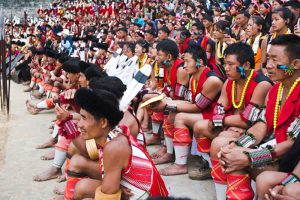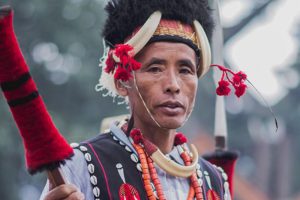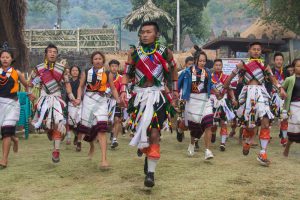
art of travel
What’s New
STAYS TO WATCH OUT FOR
New Hotels
We Are Excited About

Villa in the Woods at RAAS Devānya
A three-bedroom homestay situated between Bhimtal and Mukteshwar in the hills of Kumaon, the Villa in the Woods promotes conscious community living. Built as part of the larger sustainably engineered, eco-conscious development called Devānya, the villa allows guests to go off the grid, and yet have access to the luxuries for a comfortable stay. The fully serviced villa serves a mix of international, Kumaoni, and Rajasthani home-cooked delicacies using seasonal organic produce and grain that is either grown on Devānya’s organic farms or sourced from local farmers. Guests can go for a trek to the stream, walk to the ancient temple, do mountain biking, or unplug from technology and simply connect with nature.
Write to your relationship manager for more details

Taj Guras Kutir Resort & Spa, Gangtok
The Taj Group has expanded its footprint in Northeast India with the opening of Taj Guras Kutir Resort & Spa in Gangtok, the capital city of Sikkim. Nestled in the alpine landscape of Sikkim, the 69-key resort offers panoramic views of the majestic Kanchenjunga. Bringing in the picturesque vistas of the outdoors, each room features a Thangka, the local Buddhism-inspired paintings. Guests can embrace well-being at J Wellness Circle, trek in the Himalayas, experience the serenity of a Buddhist monastery, or simply relax amidst nature.
Write to your relationship manager for more details
EXPERIENCES TO WATCH OUT FOR
New Experiences

- Faith Engraved Into Mani Stones, Leh
- Exploring the Ancient Art of Painting on Plaster, Jaipur
- From the Seaside to a Masterpiece, Udaipur
- The Art Metal Engraving, Jodhpur
- Cabin Food Walk, Kolkata
- Two Faces of Goa
We Are Excited About

Faith Engraved into Mani Stones, Leh
Mani stones carved with Buddhist calligraphic mantras and auspicious motifs are found all over Ladakh and the Trans-Himalayan region. On any tour of Ladakh, you are bound to come across ‘mani stones’. The universal mantra of the Avalokitesvara Buddha ‘Om Mani Padme Hum’ is etched into these smooth stones with hammers and chisels. We invite you to immerse yourself in this little-known side of Himalayan culture and discover the dexterity with which the artist transforms an ordinary stone into an auspicious object of prayer.
Write to your relationship manager for more details
ITINERARY OF THE MONTH
2 nights in Alleppey

Learn About

- The golden days of Alleppey, when it was a major port of India in the 18th century, second only to Mumbai.
- How people from all over India were invited to Alleppey (just like the Maharaja of Jaipur did when he built his new city in the 18th century) to settle down and trade, what all was done to promote trade, and how the descendants of these various communities from Gujarat, Rajasthan, Maharashtra, et al stayed on in the backwater town.
- Alleppey – the Coir Capital of the world. The Coir industry, driven by the golden-coloured thread made from coconut husk employs nearly 7,00,00 people. It all began in 1859 when James Darragh, an Irish-born American set up the first coir manufacturing industry to produce and export coir products, such as coir mats and floor coverings, etc. Enterprising Indians followed James Darragh in the next one hundred years. Pollachi in North-western Tamil Nadu along with Alleppey and Cherthala in Kerala produces 60% of the world’s coir. Include Sri Lanka which is competition and that will make it 96% of the entire supply of coir and coir products worldwide.
Hosted by Locals

Guests will be hosted by a lovely couple who are Alleppey locals. Their homestay is located in the centre of Alleppey Town. “Built in the 1960s on an acre of land, it has 3 simple; yet comfortable rooms – air-conditioned, well-lit, spacious, and airy with big windows and bathrooms. We loved the airy verandah with its perforated wall where we had our pre-dinner drinks in complete privacy,” says Kuntil Baruwa from our Destination Knowledge Centre who stayed here, whilst designing this 2 night Alleppey programme.
Write to your relationship manager to know more
NEW HANGOUT SPOT
A charming café under the shadow of Qutub Minar

The Café Stone is a new hangout spot that has emerged adjacent to the historic site of Mehrauli Archaeological Park. Surrounded by lush greenery, the café is set up in a stone-built circular heritage monument overlooking the water body. The location of the café offers a beautiful view of the Qutub Minar from one side and of gushing fountains which get illuminated by sunset from the other side. Visitors can feast on history and some good food while exploring the historic park.
Write to your relationship manager for more details
Stories from India
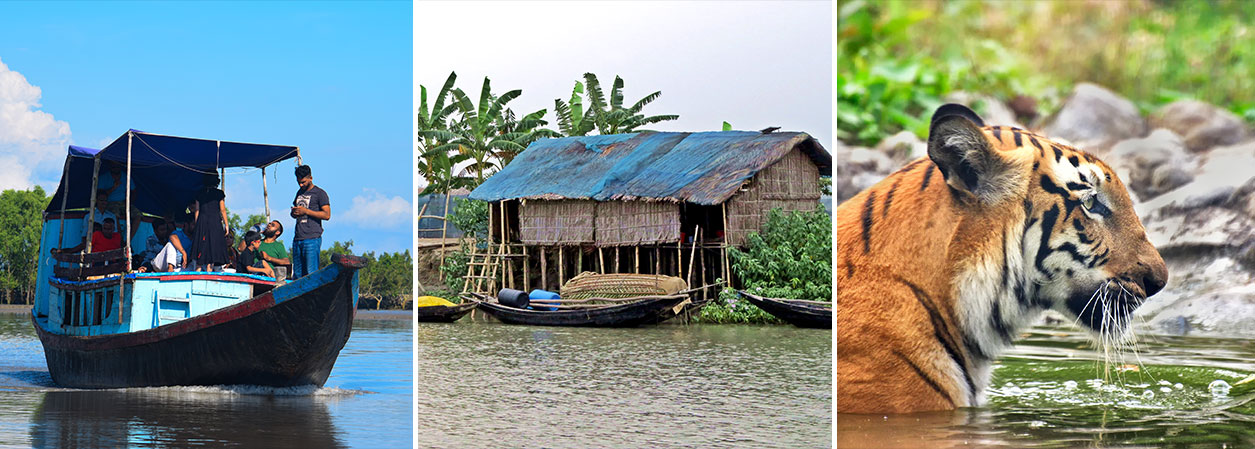
Sunderbans – The Forest of Tides and Tigers
Part of the world’s largest delta formed by the River Ganga, Brahmaputra, and Meghna across India and Bangladesh, Sunderbans, a UNESCO World Natural Heritage Site and home to the famous Royal Bengal Tiger, is the largest mangrove forest in the world. In 1984, over 1,330 square kilometres of Sunderbans was identified as the ‘core zone’ and declared a National Park. Although the core zone is off-limits, the buffer zones are open to visitors.
It is a three-hour journey from Kolkata and then a boat transfer from Sonakhali /Gadkhali to the mangrove forests of Sunderbans. Although the forests are open all year round, the best time to visit is between September and March. Due to the geographical constraints of the landscape, it is only possible to travel into the interiors of the forests via boats and ferries through backwaters, hopping from one island to another.
Everywhere you go in the Sunderbans, stories of the benign forest goddess Bonbibi and her warrior brother Shah Jongoli are never too far away. Their nemesis Dakhin Rai, known to appear as a ferocious tiger with earth-shattering roars, is always on the lookout for humans who unwittingly stray into his territory. Locals believe that while the inhabited part of Sunderbans is Bonbibi’s realm, Dakhin Rai rules the deep forests. Traditionally, Bonbibi’s blessings are sought for protection from tiger attacks before entering the jungles. Sunderbans’ tigers have adapted marvelously to the marshy land and are powerful swimmers. They drink saline water and feed on fish, turtles, monitor lizards, chital and wild pig.
Insider Tip: While at Sunderbans go on our specially curated full-day tour inspired by the lore of Bonbibi and Dakhin Rai for a never before take on the mangroves of Sunderbans. We also have a 60 minute webinar on the Folk Traditions and Folklore of Bengal that talks extensively about the legend of Bonbibi and Dakhin Rai.
Write to your relationship manager for more details
Sustainability and Us
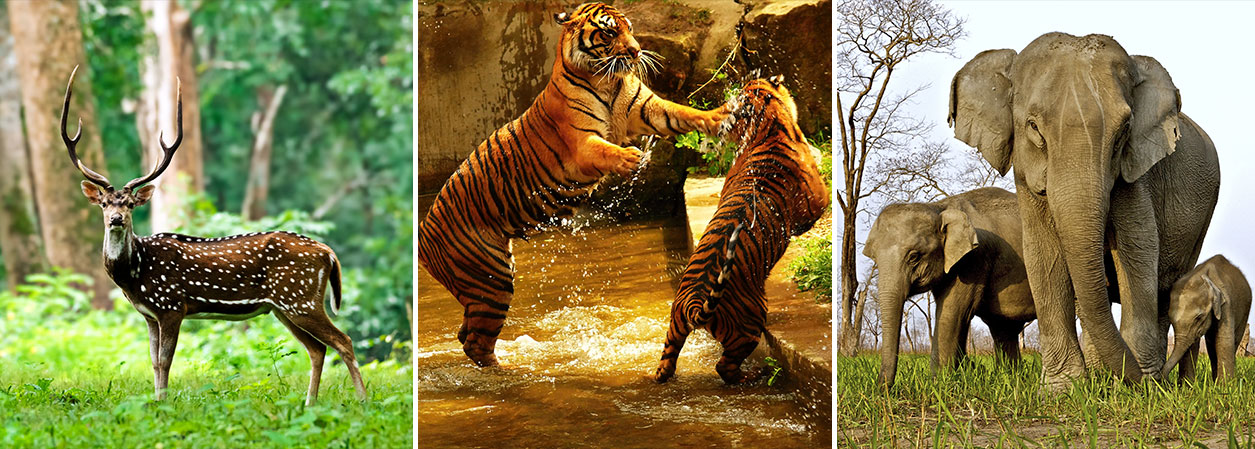
Rethinking Wildlife Tourism and Conservation
By Dr. Raghu Chundawat
This year’s Tiger Status report estimates that India now supports a population of approximately 3,682 tigers, and 80% of them survive within heavily protected tiger habitats such as Tiger Reserves, National Parks and Wildlife Sanctuaries. Though this has been a successful conservation model, its reach has remained within the boundaries of Protected Areas (PA). India has extensive tiger habitats outside (85%) of our protected areas system (15%) that can support 8-10,000 more tigers. The tiger forest outside the PA network sees little conservation and as a result, these forests are now devoid of much wildlife.
The Protected-area-based model is an exclusive conservation model, where local communities are kept out. But tiger forests outside this PA network need a conservation model that is inclusive of the local community and creates an environment where economic benefits are generated through nature-friendly activities. Such a parallel conservation approach has the potential to also strengthen the existing protected area-based system. A combined approach can help both wildlife conservation and rural development in a very positive way: it can bring attention to a large portion of tiger habitat that has not seen conservation efforts for decades and can extend the reach of tiger conservation beyond our protected areas while also bringing economic benefits and employment opportunities for communities living there.
A study we conducted estimated that in the current conservation model, the industry generates approximately ₹650,000/sq.km of tiger forest where tourism is operating. Scotland generates £ 1.4 billion every year from walkers and other adventure and nature-based tourism activities. South Africa’s nature-based tourism contributes approximately 3% of the GDP and most importantly 4.3% of the total employment. The Government of India in the last few years spent more on its forest areas than the revenue that has been generated from them. Despite India’s many wildlife conservation successes, the scope and contribution of wildlife tourism is minuscule.
The potential for nature based tourism in India, as a driver for economic development of rural population and conservation, is huge. Globally, conservationists, communities, governments and investors have recognised the role of cooperatively managed forest resources for the benefit of the communities and for protecting our environmental security. But in India, forests and thus conservation are almost entirely in the hands of the Government. Extending the existing wildlife tourism model cannot take us forward. The current model is not designed, promoted nor guided by wildlife conservation principles. We need to change our wildlife tourism model, so that it can play an important role in conservation. Despite its shortcomings, nature based tourism in many tiger reserves does currently generate an amount almost equal to the federal and state government’s contribution, but its role and impact is negligible. This needs to be changed. We estimated that almost 56% of the total turnover from tourism goes directly to the local community but it does not lead to any conservation action from the beneficiary. If this can be changed, and economic benefits are linked to conservation action by the beneficiary, a true conservation tourism model can be developed. This approach can turn the entire tiger landscape tiger-friendly; this is the power nature based tourism holds. Since the link between economic benefit and conservation action is missing, tourism is currently seen more as a threat and all attention are directed to its negatives without much note of the positive contribution. The sooner we change our approach, the faster we can contribute to improving climate change issues, rural poverty, tiger conservation and employment.
*** This article is a part of our yearlong showcase of The Sarai at Toria’s incredible journey setting the blue print of what a responsible business in hospitality should look like. Dr. Raghu Chundawat is a conservation biologist whose main studies have been on snow leopards and tigers. His pioneering ten-year research on tigers took place in the Panna Tiger Reserve and has been immortalised in the BBC Natural World documentary, “Tigers of the Emerald Forest”. Dr. Raghu Chundawat is the co-owner of Sarai at Toria.
Explore
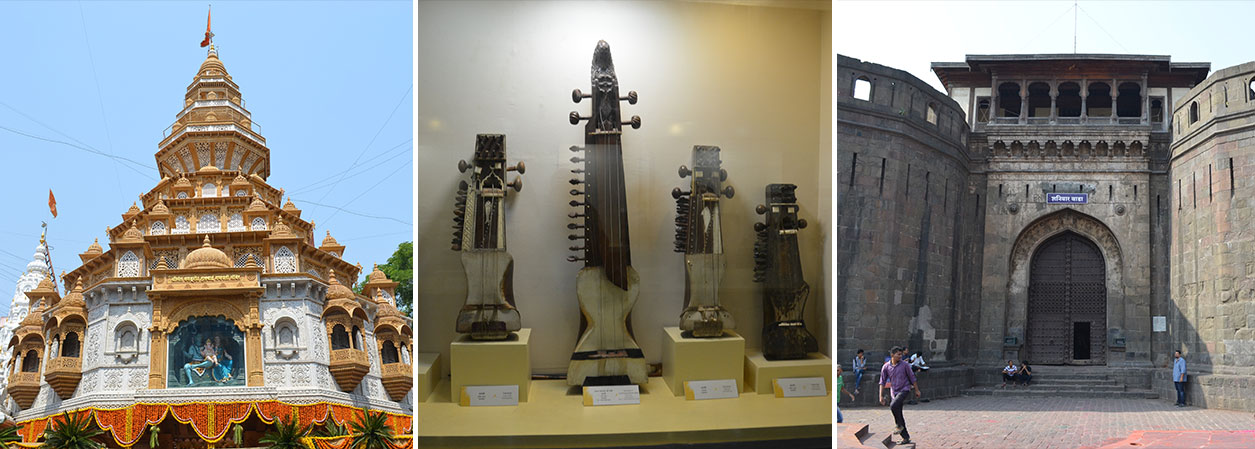
Pune – The Cultural capital of Maharashtra
Pune with its pleasant weather is endowed with a rich history, culture, and traditions along with a vibrant and progressive society. It is the 9th most populous city in India and the 2nd most populous city in Maharashtra (after Mumbai). The city is situated at 560 metres above sea level on the Deccan Plateau with two rivers Mula and Mutha flowing by. In the last decade or so, the city has experienced swift growth in industrial, commercial as well as educational sectors therefore it is often referred to as the ‘Detroit of India’ or ‘Oxford of India’.
To explore Pune in a relaxed way, one needs to devote at least 2 full days of sightseeing to this city. If you are a first timer you can choose to mix and match between various sites to visit along with a few interesting experiences on offer. There is also an option of customising your itinerary as per your preferred interest – be it history, adventure, religion, food, architecture, etc.
The best time to visit
The ideal period to visit Pune is from October to March. The days are breezy but pleasant and the nights are slightly chilly with clear skies.
Top Attractions of Pune
SHANIWAR WADA was built in the 18th century by Peshwas as their primary seat and residence. Originally 13 stories tall, the wooden structures of the Palace were gutted in a devastating fire in 1828. Its glory can still be observed in the five gateways, bastions, and court halls. The principal gate is called Dilli Darwaza (Delhi Gate); the other gates are called Mastani or Alibahadur Darwaza, Khidki Darwaza, Ganesh Darwaza, and Narayan Darwaza. A lotus-shaped fountain bears testimony to the exquisite architecture of the Peshwa dynasty.
The 8th-century PATALESHWAR CAVE TEMPLE in the heart of the city has been hewn out from a single massive rock supported by huge pillars. Inside are an oversized Shiva Linga and idols of Nandi the Bull (the vehicle of Lord Shiva), Ram, Sita, and Lakshmana (characters from the ancient epic Ramayana) as well as other Hindu gods.
AGA KHAN PALACE was constructed in 1892 by Sultan Mohammed Shah Aga, replete with Italianate arches and spacious lawns. It was gifted to the city of Pune in 1969 by the Aga Khan family as a tribute to Mahatma Gandhi and his philosophy. During the Indian freedom struggle, Mahatma Gandhi, and his wife Kasturba Gandhi were kept under house arrest here. Kasturba Gandhi passed away during her captivity at the Aga Khan Palace. The exhibits include personal articles of Kasturba and paintings of the freedom movement; the shop here sells hand-woven fabric and Khadi fabric, an iconic trademark of the Mahatma’s efforts to urge people to wear simple homespun garments.
RAJA DINKAR KELKAR MUSEUM is housed in a quaint building and holds Dr. Kelkar’s collection of pan-Indian artefacts. The museum was built in memory of his son Raja who died young. It was later donated to the State Government. Exhibits include a staggering array of copper and brass utensils and vessels, woodcarvings, paintings, murals, armours and weapons, nutcrackers, musical instruments, and a beautifully appointed room with chandeliers and paintings.
SINHAGARH HILL FORT is situated on an isolated cliff of the Sahyadri Mountain range and is located 20 km southwest of Pune. The fort has 2 Gates – the Kalyan Darwaza in the southeast and the Pune Darwaza in the northeast. Sinhagarh has an illustrious history. It was captured from a Koli tribal chieftain by Muhammad bin Tughlaq in 1328 AD. Three centuries later Chhatrapati Shivaji wrested it away by bribing the Mughal commander. In 1665 he had to cede it to back the Mughals by Treaty of Purandar. In 1670 CE Sinhagarh was the site of one of the most heroic battles fought in Maratha history when Shivaji’s forces led by Tanaji Malusare recaptured it from the Mughals, with Tanaji laying down his life to win this battle. On his death, the saddened Chhatrapati Shivaji said, “The Fort is won, but the Lion is gone!” – The fort was promptly renamed Sinhagad in memory of Tanaji – Sinha (meaning lion) and Garh (meaning fort).

Our Favourite Tour
History and Good Food in Old Pune
It starts at Shaniwar Wada – the 18th-century fort located right in the middle of the city, once the seat of the Peshwa dynasty. The next stop is Kasba Ganpati Mandir – one of the most ancient temples in the city installed by the Maratha warrior Shivaji Maharaj’s mother Jijabai in the year 1639 CE. It is famous for holding the largest ‘pandal’ (tented space) during the annual Ganpati festival in August – September. Later walk across the brassware workers colony called Tambat Ali (‘Tambat’ means Bronze and ‘Ali’ means street). Making brass utensils is a dying art now since not many people prefer to use them. One can invariably hear and even see the craftsmen striking and beating copper sheets into shape. A short walk from here is the Shreemant Dagdusheth Halwai Ganpati Temple, the most visited temple in Pune. Interestingly it celebrates the ‘Mango Festival’ every year sometime in March – April. The temple premises are decked with heaps and rows of ripe golden mangoes whose mild sweet scent fills up every corner!
Hereafter walk to Shrikrishna Bhuvan to have the typical breakfast of Pune locals which is the Puneri Misal (savouries mixture in a spicy watery dish), Shira (sweetened pounded wheat or Sooji Halwa), and Taak (buttermilk). The eatery was established in the year 1941.
After breakfast walk down to Tulshibaug – It gets its name from the Tulshibaug Wada located in this area which has a famous temple. The interior of the temple is an architectural marvel with intricate woodwork, stonework, and lime stucco-work. A 5-minute walk from Tulshibaug is Vishrambaug Wada – a fine mansion located in central Pune which was the luxurious residence of Peshwa Bajirao II, the last Peshwa of the Maratha confederacy in the early 19th century. It is famous for its finely carved woodwork at the entrance and the balcony. Currently, it hosts a Post Office on its ground floor, a few other Offices of the Municipal Corporation, and a small Museum of Maratha artefacts. A stone’s throw away from Vishrambaug Wada is Nana Wada, another surviving remnant of the Peshwa architecture. Built in 1780 CE by Nana Phadnavis, the Peshwas’ Chief Administrative Officer, it currently has a School (Nutan Marathi Vidyalaya) on its premises along with an office of Old records.
The second stop for food during the walk is Poona Guest House where one can taste Puran Poli, Thalipeeth, and Dadpe Pohe. Puran Poli is a sweet flatbread prepared with chickpea flour, grated coconut, and jaggery. It is served with clarified butter (ghee) on top. Thalipeeth is a type of savoury multi-grain pancake. Its dough is prepared with special flour made from various lentils, coriander seeds, cumin seeds, wheat, and rice. Onion, fresh coriander, other vegetables, and spices are added when kneading the dough. Dadpe Pohe is made with a thin variety of poha (flattened rice) and a paste of freshly grated coconut and pan-fried spices (mustard seeds, cumin seeds, green chillies, curry leaves and onions). It is garnished with whole groundnuts for a perfect presentation.
The second last stop of this Heritage Walk is Mahatma Phule Mandai – the largest market in Pune having about 526 stalls of fruits and vegetables. The market was built by the British in 1886 CE and was originally called Reay Market. It was later named Mahatma Phule Mandai after Independence, in honour of Pune’s great social reformer Mahatma Jotiba Phule. The structure has a beautiful medley of Gothic features with Indian detailing and comprises eight wings extending from the central structure with eight entry/exits.
The last stop after a long walk is a stopover at Gujjar Cold Drink House, to quench the thirst. It serves the most famous cold drink of Pune called MASTANI. It’s a mix of ice cream, milk, and dry fruits. The drink was earlier called ‘ice cream cold drink’ however when the customers started exclaiming ‘it’s a mast drink’ (meaning it’s a yummy enjoyable drink) it got named as ‘Mastani’ – named after Peshwa Bajirao’s lover called Mastani. Peshwa Bajirao was the ‘Prime Minister’ of the Maratha Empire.
This walk lasts for about 4 hours and can be done only in the mornings.
Accommodation
Pune offers a variety of accommodations ranging from budget-friendly hotels and guesthouses to mid-range hotels and upscale resorts. The city caters to diverse preferences, providing choices in different neighbourhoods to suit various lifestyles and budgets.
Some of the well-known Hotels and Resorts in Pune are:
-
- The Westin Pune Koregaon Park
- Vivanta By Taj – Blue Diamond
- Vivanta Pune, Hinjawadi
- Atmantan Wellness Resort
- Hyatt Regency
- JW Marriott
- Radisson Blu Pune
- Courtyard By Marriott Pune
- Crowne Plaza Pune City Centre
- Doubletree By Hilton Pune Chinchwad
- Fairfield By Marriott
- Four Points By Sheraton
- Holiday Inn
- Ibis Pune
- Lemon Tree
- Royal Orchid Golden Suites
Accessibility
Pune is accessible through the following Cities / Towns of Maharashtra:
-
-
- Mumbai, the metropolitan city lies 160 km North-west of Pune
- Nashik, the Temple Town is about 230 km up North of Pune
- Aurangabad, the historical city of Maharashtra is about 240 km in the North-east direction
- Fratelli Vineyard, located near Akluj town is about 200 km South-east of Pune
- Ganpatipule, the famous town of Konkan (the coastal belt), is approximately 300 km South-west of Pune
-
The Pune Railway Junction is located about 3 km away from the city centre.
Pune International Airport, renamed Chhatrapati Sambhaji Raje International Airport, is about 12 km from the city centre.
Weaving it into an itinerary:
Mumbai – Nasik- Aurangabad -Pune – Akluj – Ganpatipule – Sawantwadi – Goa
Write to your relationship manager to know more
Inspiration
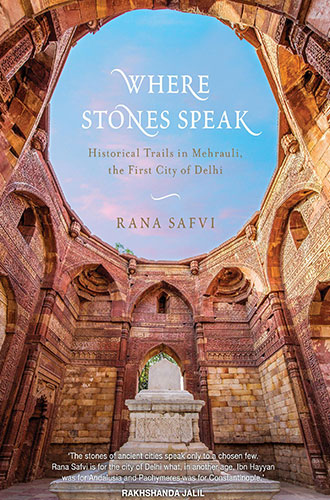
Book Review by Bene Eapen
Title of the Book: Where Stones Speak: Historical Trails in Mehrauli
Name of the Author: Rana Safvi
Genre: Travel / Short Stories
Language: English
My View: Where Stones Speak is pithily summarised and dexterously marshalled information about Mehrauli one of Delhi’s oldest jewels. It is an intricate mélange between old monuments, narrow lanes, dargahs, mosques, temples, churches, and tales of a bygone era.
My Rating: Good Read
Central Idea of the Book:
Mehrauli is the oldest of Delhi’s seven cities. Once the thriving capital of the Tomar and Chauhan dynasties and the Darul Khilafat of the slave dynasty, today it lies forgotten. Its congested lanes and crumbling ruins are lost in a mishmash of history and modernity, the living and the dead rubbing shoulders with each other. Blending stirring Urdu couplets with haunting visuals, author Rana Safvi walks us through the oldest of Delhis, describing the religious diversity of Mehrauli’s monuments: from the rocky Qila Rai Pithaura to the Dargah of Khwaja Qutbuddin Bakhtiyar Kaki, from Zafar Mahal, the last great monument built by the Mughals, to the holy waters of the Hauz-e- Shamsi. Embellished with stories and legends of a bygone era, and soaked in the sights and sounds of Sufi dargahs, mosques, temples, churches, gurudwaras, and Buddhist monasteries, Where Stones Speak effortlessly reveals a little-known, bewitching Mehrauli.
Festivals to Look Out For
Hornbill Festival, Kohima, Nagaland
December 01-10, 2023

Around the end of November, as the winter chill slowly sets in, there is a buzz of activity in Kohima, the capital city of Nagaland in Northeast India. Preparations begin for the annual Hornbill festival which commences from the first day of December. Organized by the state’s Tourism department since the year 2000, the Hornbill Festival has placed Nagaland’s beautiful mountainous capital on the world travel map.
The Nagas of Nagaland are a vibrant and colourful people comprising over 18 major tribes and many smaller tribes, each having its language, dances, customs, and traditions. With the Nagas of almost every tribe descending at one place to celebrate, the Hornbill Festival has become a window for a fantastic sneak peek into the unique and diverse Naga culture. It is a once-in-a-lifetime opportunity for anyone interested in indigenous culture.
December and January are important months for Nagas. With Christmas approaching, the predominantly Christian state wears a festive look. Homes are brightly lit up with decorations and Christmas music fills the air.
Where to Stay
Located close to the venue of the Hornbill Festival, Niraamaya Retreats Aradura offers a countryside escape amidst some of the most beautiful scenery in the region. The charming rooms (12 in total) and the spectacular vistas make for a rewarding stay. The Kohima Cathedral which is a must-see is a 15-minute walk from the property.
https://www.niraamaya.com/aradura-kohima/
Insider Tips
Make sure to book your trip to the Hornbill Festival at least a year in advance. Avoid staying in downtown Kohima during the Hornbill Festival as you are likely to get caught in the traffic snarls and waste a lot of time on the road.
Write to your relationship manager for more details
Picture Gallery
The tribes of Nagaland celebrate their festivals with great fervour. More than 60% of the population of Nagaland depends on agriculture and therefore most of their festivals revolve around agrarian traditions and are considered sacred.
Nagaland is known as the land of festivals as each tribe celebrates its own festival. Some of the important festivals celebrated are Tsukhenyie by the Chakhesang tribe in January, Sekereyni by the Angami Tribe in February, Aoling by the Konyak Tribe in April, Moatsu by the Ao Tribe in May, Tuluni by the Sumi Tribe in July, Nyaknylum by the Chang Tribe in July, Tokhu Emong by the Lotha Tribe in November and Yemshe by the Pochury Tribe in October.
The Hornbill Festival was started in the year 2000 during the first week of December (Dec 01-10) to encourage cultural exchange between the different Naga Tribes and to showcase the diverse cultural heritage of Nagaland.
Write to your relationship manager to know more about our copyright free digital photo library
RESOURCES
SITE LINKS
CONTACT US
+ 91 (124) 4563000
Tower B, Delta Square, M.G. Road, Sector 25, Gurgaon - 122001, Haryana, National Capital Region of Delhi, India




